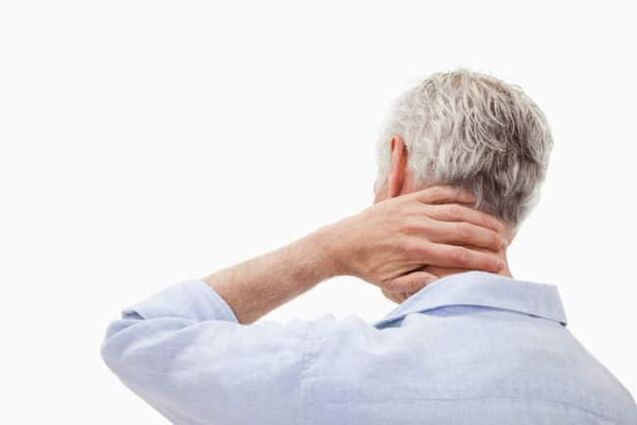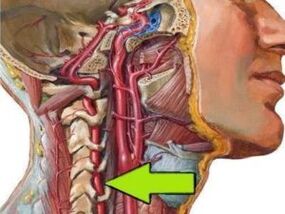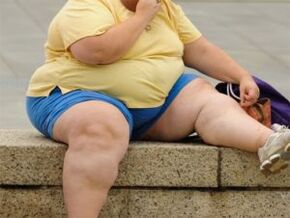Of all the pathological processes that influence the spine in its different parts, cervical osteochondrosis is considered one of the most common and painful.This disease leads to many complications, especially because it influences the spinal cord and also has a negative influence on the functioning of the brain.

What is cervical osteochondrosis?
The words of cervical osteochondrosis in medical practice mean an acquired progressive disease that influences the specific spine.This pathological process is characterized by degenerative dystrophic processes in the tissues of the intervertebral discs, which are shock absorbers for the cervical vertebrae.Degenerative dystrophic changes in the intervertebral discs are due to the fact that they are erased and distorted.As a result, the distance between the vertebrae is reduced and therefore the following consequences occur:
- Limiting the spine in certain parts of the spine.
- By passing the vertebral arteries - large blood vessels that offer blood supply to the brain.This disturbs the supply of the brain and blood circulation in the cervical spinal cord is disturbed.
- Intervertebral discs can be deformed and flattened.This leads to the pressing of individual parts of the spinal cord and nerves, the nerve roots are pressed more often.
All these problems not only threaten a violation of the blood circulation of the brain, sore sensations in the neck, headache, etc. The development of osteochondrosis of the cervical area is dangerous with problems of a neurological nature, deterioration of the central nervous system, damage to brain tissue.According to the international classification of diseases, various individual codes were assigned osteochondrosis of the cervical region.The Codode for ICB 10 depends on the age of the disease: the disease has been diagnosed:

- M02 - Dystrophy of intervertebral discs in adolescence.
- M42.12 is a dystrophic process in the neck in adults.
Many factors depend on the age of the patient and the degree of development of the pathological process, for example consequences, complications, symptoms and, of course, the principles of treatment.
Causes
Knowing the causes of the development of osteochondrosis of the cervical region can play a decisive role in the diagnostic process and determine the principles of combating the disease.However, before it states the reasons, it is worth saying that doctors distinguish two factors that lead to the development of this pathological process:
- Pathological - The destruction of the intervertebral discs and other vertebrates with the involvement of nearby tissues, blood vessels and nerve rays in the pathological process under the influence of unfavorable external factors.The harder these factors and other pathologies, the faster the disease develops.
- Physiological - based on the development of pathology, mainly age -related changes.We are talking about the natural aging of cartilage tissues in the spine, salts, etc.
If we mention more specific causes of cervical osteochondrosis, they are as follows:
- Violation of metabolic processes in the body, as well as certain stages of obesity.
- Hypodynamation is a phenomenon that is characterized by a limitation of mobility.It is not just about injuries or diseases, this can also include a sedentary lifestyle and sitting work.
- Pathologies of the cardiovascular system, which contributes to reduced blood circulation in the brain, pressure changes and other things.
- Incorrect attitude, these are different forms of scoliosis, rheumatism and even flat feet.
- Injection of the cervical spine.In this case we are talking about sprains, strikes, bruises.Research into other spine in the development of cervical osteochondrosis can influence the development of cervical osteochondrosis.
- Excessive physical exertion on the cervical region caused by intensive sports or seriously physically difficult, depending on the type of human activity.
- A sitting lifestyle is also dangerous with a constant tension of the cervical spine and the entire spine, if you are incorrect or on uncomfortable furniture.
- A hernia of the cervical spine, as well as various related diseases.
- Forced long -term holding of the head in an uncomfortable or unnatural position.In this case not only muscle excavation occurs, but the spine is also bent in the cervical area.
- The doctors consider constant stress and nervous spanning as a common cause.
- One of the reasons is also considered birth defects in the structure of the spine.

What is the risk of health?
As mentioned earlier, the cervical spine not only contains the spinal cord and different nerve branches, but also the spinal arteries that supply the occipital part of the brain, the cerebellum and the medullavian brain.With the development of cervical osteochondrosis, tissues in the neighborhood are inflamed.In addition, the development of pathology threatens to press nerve roots and transfer blood vessels, the consequences are as follows:
- Osteochondrosis is accompanied by deformations of the spine, a consequence of which the brain canal is infected in certain areas.This can lead to pressing the spinal cord and nervous branches, which promises serious neurological problems.In severe cases a person feels pain, even there is a possibility of loss of control over individual parts of the body (mainly in the hand or face).
- The pressing of the barrels of the neck, as already mentioned, is accompanied by a violation of blood circulation in the occipital area of the brain.At the same time, the brain starts to receive the required amounts of oxygen and nutrients, the oxygen hunger begins.With blood circulation disorders there is a real risk of ischemic stroke and various neurological pathologies.
Syndrome
The most important syndromes are:
- Vertebra.
- Vertebral artery.
- Koreshka.
- Heart.
It is important to know that each of these symptoms is accompanied by painful sensations of different nature, as well as many unfavorable clinical signs.A person can feel dizziness, a sound appears in his ears and much more.

Vertebral syndrome
It talks about the direct connection of osteochondrosis of the cervical area with bone and cartilage tissues.Symptoms in this type of pathology are also associated with the lesion of the aforementioned tissues:
- The movements of the neck are partially or completely limited.
- The movements of the head are accompanied by neck pain.
- X -Ray shows morphological changes in the tissues (intervertebral and in the body of the vertebrae).
It is worth mentioning that the vertebrae syndrome is always accompanied by these three clinical signs.If at least 1 of them is absent, the diagnosis is completely different.
Smoke Syndrome
It occurs when the roots of the spinal cord are damaged.At the same time, nervous conductivity is disturbed, a person can feel pain or losing the sensitivity of individual parts of the body or even suffer from paralysis.Depending on which of the 8 radicular pairs, there is a disruption of the conductivity, such symptoms are distinguished:
- 1 pair - numbness or pain in the back of the head;
- 3 pair - violation of the chewing reflex, numbness of the tongue and unpleasant sensations behind the ears;
- 4 pair - pain in the collarbone, violation of the swallow reflex;
- 5 pair - violations of the shoulder girdle, accompanied by the problem of hand movement;
- 6 pairs - the patient starts to feel pain and numbness in the forearm and shoulder blades;
- 7 pairs - hands and fingers become numb (often index and center);
- 8 pair - problems similar to the past item, but numbness is felt in the ring finger and little finger.
Cardiac syndrome
Despite the fact that the pathological process is still located in the cervical spine, the syndrome has all the signs of heart pathologies.The clinical image is as follows:
- Fast wrist.
- Pain in the region of the breastbone.
- Shortness of breath, weakness, lethargy, performance of performance.
Drawing and symptoms of cervical osteochondrosis
For timely searching for a doctor it is necessary to clearly understand the signs of cervical osteochondrosis.In some cases, such a knowledge enables you to seek help in the initial phase of the disease, when it is easier to treat.In general, the symptoms for osteochondrosis of the cervical spine are as follows:

- Pain for osteochondrosis is always present, only intensity and frequency differ.It is pain that is the first clinical sign.Their intensity depends on the stage of progression of the disease, in nature they are stupid or squeeze.Painful sensations are mainly present in the neck of the occipital area, but can also shine to the temporary area, shoulder girdle and hands.
- In most cases there are manifestations of the lesion of the vestibular device.We are talking about frequent cause -less dizziness, nausea, reduced coordination of movements, uneven loop, loss in space.
- One of the most common clinical signs is the stiffness of the neck muscles and the stiffness of movements.It is difficult for a person to turn, lower it and throw his head away, respond movements with pain attacks.
- Many patients notice the feeling that goose bumps "run through the scalp" or a characteristic tingling is felt.
- In the area of the hands there is muscle weakness and numbness.
- Often there are psychological manifestations, expressed in depression, sleepiness, a sharp change in mood, mood or irritability.
- Due to the reduced blood circulation and damage to the brain tissue, dizziness is intensified and the sound appears in the ears, similar to rustling, pulsation, ringing.
- Most patients notice visual limitations, as well as pain in eyeballs, especially when they try to mow the eyes to the left, right, up or down.
It is sometimes possible to determine the degree of development of the pathological process through symptoms.For a complete diagnosis of this, however, this is still not sufficient and a number of diagnostic measures are required.
Diagnostic methods
Diagnosis of osteochondrosis of the cervical spine is necessary to determine the localization and stage of progression of the disease.For complete diagnosis, such diagnostic methods are needed:
- X -Ray - The primary method with which you can determine the degree and localization of deformation of the spine.
- You can use computer tomography for a more accurate diagnosis of pathological changes in the vertebrae and intervertebral discs.
- MRI (Magnetoresonance imaging) - makes it possible to investigate the wheels and vertebrae in detail, to determine the presence of hernias, protrusions and the scale of lesions of the rest.
- DOPLEROGRAPHY - At the same time, the study becomes the opportunity to find a place for pressing the artery, to evaluate the degree of blood circulation.
Treatment methods
Treatment of Nek Osteochondrosis always implies an integrated approach.The principles of the treatment depend on the mass factors, such as the age of the patient, the stage of the development of the disease, the brightness of the clinical image, etc. Nevertheless, you cannot do without a doctor in this situation and in the first place you can consult a therapist that you will then lead to a vertebrolog.Regarding the integrated approach: osteochondrosis of the cervical osteochondrosis is treated with the help of drug therapy, physiotherapy, massages, exercise therapy and other methods that must be discussed in more detail.
Drug treatment
The basis for the treatment of cervical osteochondrosis is medicine therapy, involving tablets, medicines and medicines of such groups:
- Anesthetics - Analgetic and Cramps.The first directly boring nervous centers, which stops painful sensations.The latter allows you to relieve spasms of the neck muscles, to establish blood flow and suppress pain.
- NSAIDs -not -steroid anti -inflammatory drugs are needed to reduce the inflammatory process, most eliminate pain.These drugs are often used in the form of gels, ointments that are rubbed in the affected area.
- Musorelaxants are another way to remove muscle spasms in the cervical area.
- Chondroprotectors are mandatory in certain stages of Chop Osteochondrosis, because they contribute to the recovery of bone tissues.
- B Vitamins - normalize the metabolic processes of nerve tissues, improving the conductivity of nerve impulses and contributes to the work of the central nervous system.
Remember that the treatment must only be carried out under the supervision of a doctor, who is responsible for the appointment of each medicine, as well as determining the duration of the intake and dosage.
Physiotherapy
Treatment of Nek Osteochondrosis will be many times more effective with the help of some physiotherapy techniques:

- Electrophhoresis.
- Laser therapy.
- Ultrasound.
- Massage.
Massage therapy is necessarily performed by an experienced health worker, the treatment is performed by a course of at least 10 sessions.Massages of the cervical area help to normalize blood circulation, elasticity, to restore muscle tension, relieve pain, etc.
Manual therapy
Manual therapy is based on the principle of repairing engine functions and mobility between the vertebrae.Initially, the manipulations are in a slight relaxing massage, after which the doctor attaches more and more strength to the vertebrae of prints and turns of the neck.
The use of Kuznetsov applicators is one of the methods for therapy for diseases of the spine, including osteochondrosis.The effect of adjustment to the cervical area normalizes metabolic processes, relieves pain, increases muscle tone, improves blood circulation, increases the conductivity of nerve tissue, etc. To prevent osteochondrosis, it is useful for swimming and hanging on the horizontal bar for 2-3 minutes a day.




























































































